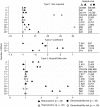Examining the generalizability of research findings from archival data
- PMID: 35858443
- PMCID: PMC9335312
- DOI: 10.1073/pnas.2120377119
Examining the generalizability of research findings from archival data
Abstract
This initiative examined systematically the extent to which a large set of archival research findings generalizes across contexts. We repeated the key analyses for 29 original strategic management effects in the same context (direct reproduction) as well as in 52 novel time periods and geographies; 45% of the reproductions returned results matching the original reports together with 55% of tests in different spans of years and 40% of tests in novel geographies. Some original findings were associated with multiple new tests. Reproducibility was the best predictor of generalizability-for the findings that proved directly reproducible, 84% emerged in other available time periods and 57% emerged in other geographies. Overall, only limited empirical evidence emerged for context sensitivity. In a forecasting survey, independent scientists were able to anticipate which effects would find support in tests in new samples.
Keywords: archival data; context sensitivity; generalizability; reproducibility; research reliability.
Conflict of interest statement
The authors declare no competing interest.
Figures

References
-
- Aguinis H., Cascio W. F., Ramani R. S., Science’s reproducibility and replicability crisis: International business is not immune. J. Int. Bus. Stud. 48, 653–663 (2017).
-
- Baker M., First results from psychology’s largest reproducibility test: Crowd-sourced effort raises nuanced questions about what counts as replication. Nature, 10.1038/nature.2015.17433 (2015). - DOI
-
- Bergh D. D., Sharp B. M., Aguinis H., Li M., Is there a credibility crisis in strategic management research? Evidence on the reproducibility of study findings. Strateg. Organ. 15, 423–436 (2017).
-
- Bohannon J., Psychology. Replication effort provokes praise—and ‘bullying’ charges. Science 344, 788–789 (2014). - PubMed
-
- Bosco F. A., Aguinis H., Field J. G., Pierce C. A., Dalton D. R., HARKing’s threat to organizational research: Evidence from primary and meta-analytic sources. Person. Psychol. 69, 709–750 (2016).
Grants and funding
- FWF/Knut och Alice Wallenbergs Stiftelse (Knut and Alice Wallenberg Foundation)
- na/Jan Wallanders och Tom Hedelius Stiftelse samt Tore Browaldhs Stiftelse (Jan Wallander and Tom Hedelius Foundation and Tore Browaldh Foundation)
- R-313-000-131-115/Ministry of Education (Singapore) Tier 1 Grant
- 72002158/National Science Foundation of China
- na/R&D Research Grant (INSEAD)

